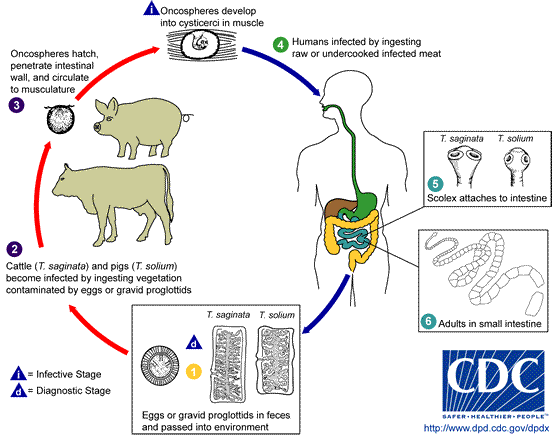Introduction to Diagnostic Medical Parasitology
Essentials
Taeniasis is an intestinal infection with either Taenia saginata, the beef tapeworm, or T. solium, the pork tapeworm. They are large cestodes reaching a length of up to 10 metres. In most cases, only a single long-lived worm infects the final host, capable of surviving for many years. Taenia solium can also cause cysticercosis, a severe tissue infection when humans serve as the intermediate host (see under cysticercosis).

Infection is caused by eating raw or undercooked meat (tartar, sausages) containing cysticerci. Humans are the only natural final host. The larvae evaginate in the small intestine and become mature worms in about 3 months. Infected patients then start eliminating worm segments (proglottids) with eggs infective for the intermediate hosts (cattle for T. saginata or pigs for T. solium). After oral uptake of eggs by the intermediate host, hexacanth embryos emerge from the eggs and leave the gut. By blood or lymphatics they reach various tissues (muscles, viscera) where they become cysticerci which are infectious for many years.
(see below) First picture shows the head of a Taenia saginata. The secound one is a head of Taenia solium.


Epidemiology
- Distribution is worldwide and related to habits of eating raw or undercooked meat
- Human faecal contamination is needed to maintain the life cycle
- Humans are the single final host
Pathology
- Taeniasis is without or with only mild symptoms
- Complications when worms migrate to ectopic sites (appendix, pancreas or bile ducts)
Clinical Findings
- Taeniasis might produce variable clinical manifestations (gastrointestinal symptoms, nausea, anorexia, weight loss, allergic symptoms, insomnia)
Diagnosis
Diagnostic methods
Parasitological diagnosis
The diagnosis relies on the detection of proglottids or eggs in fresh stool samples. Caution: T. solium eggs are infectious (see cysticercosis)!
Eggs of T. solium and T. saginata are morphologically identical.
Gravid proglottids of T. solium and T. saginata can be differentiated after ink injection (less than 13 uterine branches in T. solium, more than 15 in T. saginata).
Molecular diagnosis
No tests developed so far
Antigen detection
Detection of copro-antigens can be achieved with immunoassays. Microplate assays are more sensitive than dipsticks.
Antibody detection
Infections with adult T. solium can also be indirectly and specifically diagnosed by EITB using excretory-secretory antigens of non-gravid tapeworms.
Diagnostic strategies
- To diagnose an individual case
Diagnosis relies on coprologic examination
- To assess prevalence in an endemic area
For field studies antigen detection is an efficient method



Prevention and control
- ducate people to prevent faecal contamination of soil, water, human and animal food
- Inform people about the risk of eating raw meat
- Freezing pork or beef at a temperature below –5 C for more than 4 days kills cysticerci!